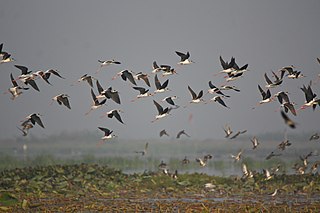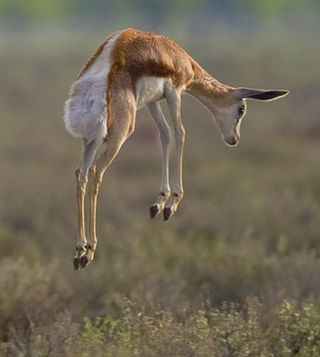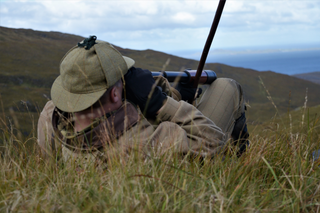
Hunting is the human practice of seeking, pursuing, capturing, and killing wildlife or feral animals. The most common reasons for humans to hunt are to obtain the animal's body for meat and useful animal products, for recreation/taxidermy, although it may also be done for resourceful reasons such as removing predators dangerous to humans or domestic animals, to eliminate pests and nuisance animals that damage crops/livestock/poultry or spread diseases, for trade/tourism, or for ecological conservation against overpopulation and invasive species.

Predation is a biological interaction where one organism, the predator, kills and eats another organism, its prey. It is one of a family of common feeding behaviours that includes parasitism and micropredation and parasitoidism. It is distinct from scavenging on dead prey, though many predators also scavenge; it overlaps with herbivory, as seed predators and destructive frugivores are predators.

Spotlighting or lamping is a method of hunting nocturnal animals using off-road vehicles and high-powered lights, spotlights, lamps or flashlights, that makes special use of the eyeshine revealed by many animal species. A further important aspect is that many animals often remain to continually stare at the light, and do not appear to see the light as a threat, as they would a human. It is possible to carefully approach animals on foot to a short distance if bright light is continuously maintained on the animal, greatly improving chances of successful killing. Spotlighting may also be used as a method of surveying nocturnal fauna. Repeated, frequent spotlighting may have a detrimental effect on animals, and is discouraged.

Wildlife management is the management process influencing interactions among and between wildlife, its habitats and people to achieve predefined impacts. It attempts to balance the needs of wildlife with the needs of people using the best available science. Wildlife management can include wildlife conservation, gamekeeping and pest control. Wildlife management draws on disciplines such as mathematics, chemistry, biology, ecology, climatology and geography to gain the best results.

The Kaibab Plateau is a plateau almost entirely in Coconino County, Arizona in the Southwestern United States. The high plain is also known as the Buckskin Mountain, Buckskin Plateau, and Kaibab Mountain.
Hunting strategy or hunting method is any specific techniques or tactics that are used to target, pursue, and hunt an animal. The term mostly applies to humans catching and killing wild animals, but can also be used in ethology and nature documentaries to describe predation strategies adopted by carnivores.

Tracking in hunting and ecology is the science and art of observing animal tracks and other signs, with the goal of gaining understanding of the landscape and the animal being tracked. A further goal of tracking is the deeper understanding of the systems and patterns that make up the environment surrounding and incorporating the tracker.

A predator trap is a natural hazard where prey animals become trapped or incapacitated, and the attracted predators suffer the same fate. More predators, scavengers, insects and birds become attracted to this mounting accumulation of carrion, until a wide variety of animals are caught and ultimately killed by the hazard. This may happen many times over. Typically, the number of lured predators will greatly outnumber the prey, thus providing the name.

Big-game hunting is the hunting of large game animals for trophies, taxidermy, meat, and commercially valuable animal by-products. The term is often associated with the hunting of Africa's "Big Five" games, and Indian rhinoceros and Bengal tigers on the Indian subcontinent.

The Predator, also known as Yautja, is the titular extraterrestrial species featured in the Predator and Alien vs. Predator science fiction franchises, characterized by its trophy hunting of other "challenging" species for sport. First introduced in the film of the same name, the creatures returned in the sequels Predator 2 (1990), Predators (2010) and The Predator (2018), and the prequel Prey (2022), as well as the crossover films Alien vs. Predator (2004) and Aliens vs. Predator: Requiem (2007). In 2023, the species was licensed to Adult Swim to appear officially in the seventh season of the animated series Rick and Morty, introducing the Skin Thieves clan.

Deer hunting is hunting deer for meat and sport, and, formerly, for producing buckskin hides, an activity which dates back tens of thousands of years. Venison, the name for deer meat, is a nutritious and natural food source of animal protein that can be obtained through deer hunting. There are many different types of deer around the world that are hunted for their meat. For sport, often hunters try to kill deer with the largest and most antlers to score them using inches. There are two different categories of antlers. They are typical and nontypical. They measure tine length, beam length, and beam mass by each tine. They will add all these measurements up to get a score. This score is the score without deductions. Deductions occur when the opposite tine is not the same length as it is opposite. That score is the deducted score.

In the United Kingdom, the term hunting with no qualification generally refers to hunting with hounds, e.g. normally fox hunting, stag (deer) hunting, beagling, or minkhunting, whereas shooting is the shooting of game birds. What is called deer hunting elsewhere is deer stalking. According to the British Association for Shooting and Conservation (BASC) over a million people a year participate in shooting, including stalking, shooting, hunting, clay shooting and target shooting. Firearm ownership is regulated in the UK by licensing. Provisions exist for those without a Firearm or Shotgun certificate to shoot under the supervision of a certificate holder.

A flock is a gathering of individual birds to forage or travel collectively. Avian flocks are typically associated with migration. Flocking also offers foraging benefits and protection from predators, although flocking can have costs for individual members.

Stotting is a behavior of quadrupeds, particularly gazelles, in which they spring into the air, lifting all four feet off the ground simultaneously. Usually, the legs are held in a relatively stiff position. Many explanations of stotting have been proposed, though for several of them there is little evidence either for or against.

Deer stalking, or simply stalking, is a British term for the stealthy pursuit of deer on foot to hunt for meat, leisure, trophy, or to control their numbers. As part of wildlife management, just as with rabbiting and boar hunting, deer stalking aims to reduce crop damage. Additionally, deer stalking has long been considered a pastime sport.
Prey detection is the process by which predators are able to detect and locate their prey via sensory signals. This article treats predation in its broadest sense, i.e. where one organism eats another.
Overpopulation or overabundance is a phenomenon in which a species' population becomes larger than the carrying capacity of its environment. This may be caused by increased birth rates, lowered mortality rates, reduced predation or large scale migration, leading to an overabundant species and other animals in the ecosystem competing for food, space, and resources. The animals in an overpopulated area may then be forced to migrate to areas not typically inhabited, or die off without access to necessary resources.
Population control is the practice of artificially maintaining the size of any population. It simply refers to the act of limiting the size of an animal population so that it remains manageable, as opposed to the act of protecting a species from excessive rates of extinction, which is referred to as conservation biology.

Pursuit predation is a form of predation in which predators actively give chase to their prey, either solitarily or as a group. It is an alternate predation strategy to ambush predation — pursuit predators rely on superior speed, endurance and/or teamwork to seize the prey, while ambush predators use concealment, luring, exploiting of surroundings and the element of surprise to capture the prey. While the two patterns of predation are not mutually exclusive, morphological differences in an organism's body plan can create an evolutionary bias favoring either type of predation.

In ecology, hunting success is the proportion of hunts initiated by a predatory organism that end in success. Hunting success is determined by a number of factors such as the features of the predator, timing, different age classes, conditions for hunting, experience, and physical capabilities. Predators selectivity target certain categories of prey, in particular prey of a certain size. Prey animals that are in poor health are targeted and this contributes to the predator's hunting success. Different predation strategies can also contribute to hunting success, for example, hunting in groups gives predators an advantage over a solitary predator, and pack hunters like lions can kill animals that are too powerful for a solitary predator to overcome.